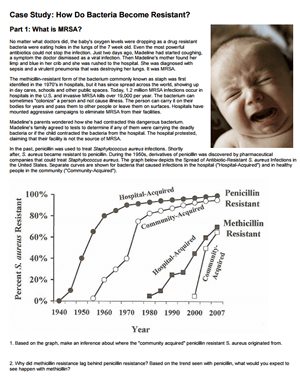
Students analyze data regarding methicillin and penicillin resistant bacteria, focusing how hospitals inadvertently drive the evolution of resistant strains. Each section of the case explores an aspect of dealing with bacteria, including sanitation, analyzing agar plates uses the Kirby-Bauer disk method and concludes with students suggesting plans for reducing the incidence of MRSA in hospitals.
With bacteria resistance becoming more common, traditional classrooms may be reluctant to do labs involving bacteria cultures, so this activity can be a good substitute. It involves data analysis and examination of images that show how disks soaked in antibiotics would affect growth.
I still grow bacteria on pre-poured agar plates, but no longer allow students to manipulate or take samples from unknown colonies. There are disposed of in buckets of bleach.
Older students, like my AP Biology class, still do the bacteria transformation lab, but these are older, college track students and the bacteria are grown from known samples of “harmless” strains. For them, this is a good experience for learning sterile technique.
Grade Level: 9-12 | Time: 1 – 1.5 hours
HS-LS4-3 – Apply concepts of statistics and probability to support explanations that organisms with an advantageous heritable trait tend to increase in proportion to organisms lacking this trait.
HS-LS4-4 – Construct an explanation based on evidence for how natural selection leads to adaptation of populations.

